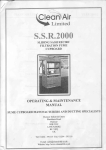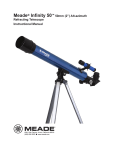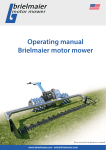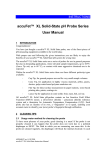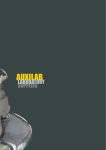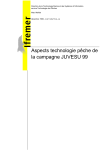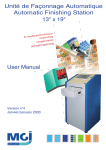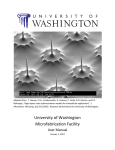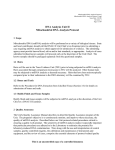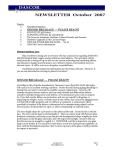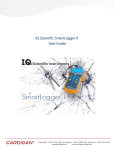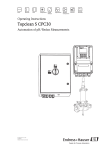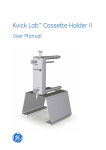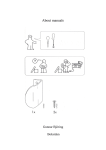Download SENTRON Stream-Line probe series User manual
Transcript
S E NT R ON S tream-L ine probe s eries Us er manual Distributor: Topac Inc 231 CJC Highway Cohasset MA 02025 Tel 781 740 8778 Fax 781 740 8779 www.topac.com email [email protected] Manual S tream-Line probe, S E NT R ON reference number E 7500180, V ers ion 1.01, April 2002 1. Introduction Congratulations! You have just bought a SENTRON Stream-Line probe; one of the finest pieces of pHmeasuring equipment available in the world today. With proper care and following the given instructions you are likely to enjoy the benefits of your SENTRON pH-system for a long time. Although also very suitable for general pH-testing, the Stream-Line probes are specially designed for low conductivity applications or highly concentrated or contaminating samples. This probe features a refillable reference-liquid compartment with a constant reference liquid outlet through a large area porous PTFE diaphragm. On top of that it is resistant to temperatures up to 105°C and to more aggressive chemicals. Within the Stream-Line series, there are two different probe types available: ConeFET, for application in highly viscous materials such as pastes, jellies, slurries, pulps, waterbased polymer-emulsions etc. SurFET, for direct surface measurement applications in paper-industry, water-based printing inks, paints, coatings etc. To avoid disapointment, please make sure you have selected the right member of the comprehensive SENTRON probe family. This can be seen from the type-name on the barrel of the probe. Other members of this family are: The SENTRON Red-Line probes, a series of probes for general purpose applications up to 60°C. The SENTRON Hot-Line probes, for use in demanding applications where higher sample temperatures, up to 105°C, or contact with more aggressive chemicals are to be expected, but a flowing reference system is not required. All SENTRON pH-probes contain an Ion Sensitive Field Effect Transistor (ISFET) sensor, a silver/silverchloride – potassiumchloride reference system and a thermistor to allow Automatic Temperature Compensation (ATC). Each probe also has an identity of its own, a “fingerprint” so to speak, enabling your SENTRON meter to identify your (new) probe’s fingerprint through calibration. 2. Cleaning tips Soapy water method for cleaning the probe To have most pleasure of your probe, good cleaning is a must! If the probe is not properly cleaned it can happen that the probe does not work due to a polluted diaphragm or ISFET. The fluid in which you are measuring can cause this. Is the probe not cleaned regularly, the diaphragm will block the internal electrode. In such case there is no electrical contact between the electrode and the ISFETchip and the probe will not work properly. To prevent this, you must clean the probe regularly. The frequency is depending of the sample you are measuring in. As reference: it is mostly also visible, the diaphragm is no longer white! Cleaning Put the probe in soapy water with a constant temperature of 60°C for minimal 5 minutes. Then start cleaning the probe with the toothbrush. After this the probe must be placed in a KCl-solution with a temperature of + 20°C for ½ hour. This ‘cold’ KCl-dip will regenerate the reference system and the diaphragm. 1 2. Safety and care The sensitive element in a SENTRON probe is an ISFET semi-conductor. This sensing element needs to be driven by an electronic circuit that is built into the SENTRON pH meters and can only perform up to its specifications when used in combination with one of those pHmeters. Any other combination might cause loss of performance and irreversable damage to both probe and meter. The fact that SENTRON probes are ruggedly built to last, even in harsh conditions, does not mean that they need no maintenance at all. Read the operating tips well, to ensure lasting satisfaction. Tris buffers and samples containing proteins should be tested quickly and the probe should be rinsed thoroughly with deionized water between samples. When testing is complete, clean with water and a laboratory detergent and rinse with deionized or distilled water. Avoid prolonged immersion in samples containing Tris or proteins. Avoid prolonged immersion in samples expected to have pH-values which lay at the ends of the specified pH-range. When unavoidable, rinse with ample water in between samples. Rinse with neutralising agents and destilled water when the measurement is completed and prior to storage. Do not use outside the specified temperature range as this might result in probe failure or irreversable damage to the probe. Samples must be aqueous solutions or semi-solids and compatible with the probes wetted materials. If information is required regarding the chemical resistance of the probe, please refer to your SENTRON meter manual or contact your local dealer. All wetted materials used are in compliance with the directives of the Food & Drug Administration (FDA) of the United States of America. 3. Daily use Remove and save the protection tube from the probe prior to use. Open the refilling hole by moving the silicon band approx. one centimeter towards the probecap, to allow reference liquid flow during operation. Check before each operation whether or not the level of the reference liquid is sufficient. If you are not sure, or if the level is too low, fill with reference liquid (See Tip 7). Prior to daily use, scrub the probe tip with a soft bristled toothbrush and water to remove KCl crystals and other possible residues. Use some mild detergent if required. Rinse with deionized or distilled water. Soak the probe in pH 7.00 buffer or pH 4.00 buffer with the meter ON (in any mode) prior to calibration for at least 10 minutes. For maximum stability and accuracy, perform the calibration sequence twice. To store the probe, clean it thoroughly with water and a soft bristled toothbrush (again, a mild detergent may be used) and rinse with deionized or distilled water. Re-adjust the silicon band over the refilling hole. Replace the protective tube. Fill the protective tube with saturated KCl 2 (see tip 1) to the level that, after replacing the probe, at least the tip of the probe is completely submerged in the liquid. Slide the screw-cap onto the probe body, followed by the sealing O-ring. Slide cap and ring onto the rim of the protective tube, press the cap down and only then tighten the screw-cap. Note: When used in samples containing small hard solid particles (e.g. pigments, titaniumoxide, silicates etc.) first rinse the probe with ample water before using the brusch. 4. Operating tips Tip 1: To prepare saturated KCl (potassium chloride) solution: Add KCl-granules to distilled water untill no more KCl will dissolve. Adding 38 grams of KCl to 100 ml water is sufficient. Let this stand for at least two hours and decant the clear solution. Now you have saturated KCl. Tip 2: To ensure correct measurement values, samples or buffers need to be mixed well. This may be done by a magnetic stirrer or by stirring with the probe for at least 5 seconds. Stop stirring and record results when the read-out is stable. Tip 3: Proteins, fats and oils may be removed by scrubbing in a solution of e.g.Terg-A-Zyme (Alconox company) a pepsin solution or a similar product. Afterwards, rinse thouroughly with deionized or distilled water. Cleaning agents are available at SENTRON, ask your local dealer. Do not use hydrofluoricacid, acetone, MEK or similar agents for cleaning. Tip 4: When testing in direct sunlight or on a bright reflecting surface, please use brown, opaque or shielded sample containers. Very bright light might influence the performance of the sensor. Tip 5: Buffer-handling: pH 7.00 buffers (phosphate-based) and pH 4.00 buffers (biphtalatebased) are less susceptible to carbondioxide contamination than pH 10.00 buffers (borax or carbonate based). When slope errors occur, it usually indicates a failing probe or a contaminated buffer. If seen when using pH 10.00 buffer, try calibrating with pH 7.00 and pH 4.00 buffer. If a good slope is achieved, try a new bottle or different lot pH 10.00 buffer. All pH-buffers can be purchased at SENTRON, contact your local dealer. Tip 6: When using ConeFET probes with semi-solids, insert probe to desired depth, then rotate left and right several times and tilt to ensure sample contact. Tip 7: Adding reference liquid to the barrel (reference gel container): the easiest way to execute this is to fill a syringe with reference liquid, move the silicone band on the barrel approx.one centimeter towards the probecap. A hole in the barrel will appear. Empty the syringe through the hole into the barrel. Repeat until a satisfactory level of reference liquid is obtained. Spare refilling reference liquid can be purchased at SENTRON, order through your local dealer. Tip 8: Slide the rubber band up/down until the hole is visible, prior to calibration and measurement to allow the reference gel to flow out of the probe. 5. Trouble shooting If any of the following events occur: low slope, drift, instability of the reading, slow calibration, probe will not calibrate, pH value doesn’t change as expected when changing samples,..... 3 Clean probe with warm (40°C / 104°F) tap water and a soft bristled toothbrush, use a mild detergent (e.g. a non abrasive soft soap). If the problem persists, as a last resort, blunt the point of a wooden toothpick, wet it and place the blunted tip directly on the sensor area (the shiny surface surrounded by black compound). Then apply light pressure and brush carefully lenghtwise or twirl the toothpick on the sensor surface. Try to avoid damaging the ISFET. Clean the surface with water and a toothbrush, rinse and calibrate as decribed earlier. 4 6. Specifications Sensor: Semi-conductor Ion Sensitive Field Effect Transistor (ISFET) sensor with patented ESD protection circuit. Operating temperature: -5°C to 105°C pH-range: pH 0 to pH 14 Reference compartment: thickened saturated KCl-gel, refillable Dimensions: Probe lenght: Probe diameter: Cable lenght: Connector: 200 mm 10 mm 1.5 mtr There are different types of connector available. Please make sure that the probe you have received has a connector that matches your meter. This can be done by checking the last two digits of your probe label: for the Argus and Titan series: 08; for 1001 and 2001 series: 01; for 3001 series: 03; for 701 series: 11. Wetted materials: Barrel and tip: Packaging material: Reference liquid: Diaphragm: Chemical resistance: Refer to your SENTRON meter manual. If doubts concerning applicability arise, please contact your local dealer. If you have purchased a new probe to fit your old type pH-meter (701, 1001, 2001, 3001), contact your dealer to receive updated information on the chemicalresistance of the probe. 5 PEI (poly-ether-imide) epoxy-resin gelled KCl porous PTFE 7. Warranty This SENTRON probe is produced, packed and shipped with the utmost care. If, the former notwithstanding, defects do arise, be advised that this SENTRON probe is warranted to be free from defects in material and craftmanship for the period of half a year. SENTRON will repair or replace, at SENTRON’s option, any defective part free of charge if this product fails within 6 months from the date of purchase, provided that the failure is due to defective material or lack of craftsmanship and has occurred under normal conditions of usage, to be judged by SENTRON. SENTRON disclaims any liability to customers, to users of its products, or to any other person or persons for any special or consequential damage that might arise out of, or that might in any way be connected with, the use of this instrument or its accessoires. The warranty described in this paragraph shall be in lieu of any other warranty, expressed or implied, including but not limited to any implied warranty or merchantability or fitness for a particular purpose. The buyer’s sole and exclusive remedy is for repair or replacement of defective parts as provided therein. Representations and warranties made by any person, including dealers, representatives and employees of SENTRON, which are inconsistent or in conflict with the terms of this warranty, shall not be binding upon SENTRON unless in writing and signed by one of its officers. SENTRON reserves the right to ask for proof of purchase, such as the original invoice or packing slip. All information contained in this manual is current at the time of publication. Our commitment to product improvement requires that we reserve the right to change equipment, procedures and specifications at any time. 6








